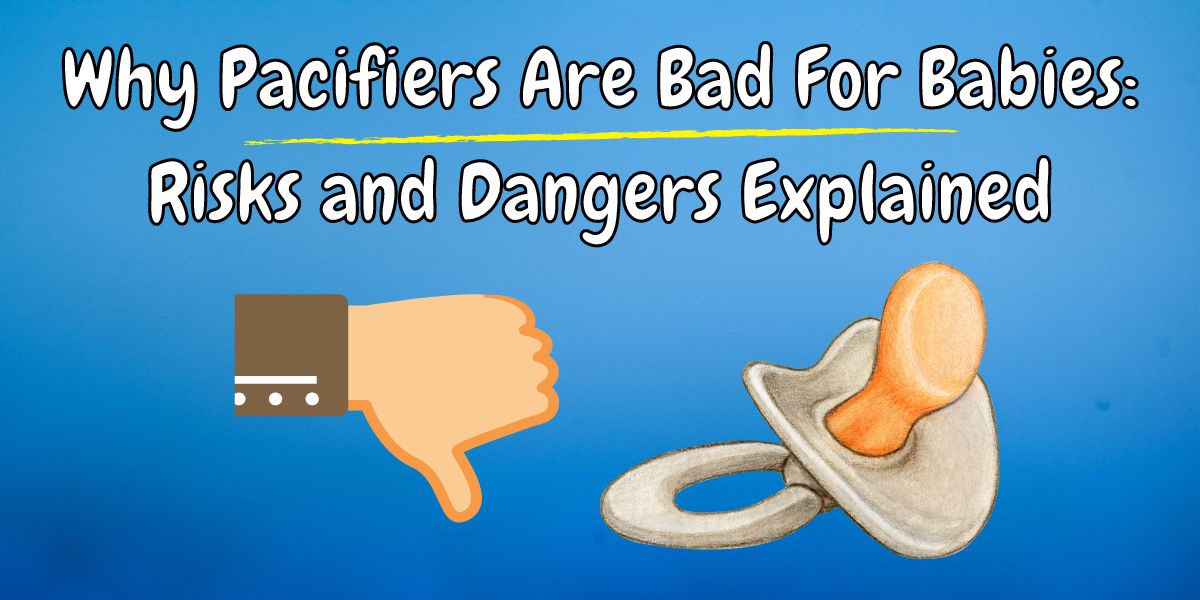Pacifiers have been a go-to for parents for generations, touted for their ability to soothe cranky infants and provide a moment of peace. However, it’s crucial to understand the potential pitfalls associated with pacifier use. From dental issues to dependency concerns, we’ll dive deep into why pacifiers may not be as harmless as they seem and what alternatives might be safer for your baby.
The Truth About Pacifiers
Understanding Pacifier Use

Brief History and Reasons Why Parents Choose Pacifiers:
Pacifiers have been used since ancient times, with early versions made from natural materials like rags dipped in honey or sweetened water. Today, they are made from silicone or rubber and are a staple in many households. Parents often turn to pacifiers to soothe babies during bouts of fussiness, help them fall asleep, and even provide temporary distraction.
Immediate Benefits Versus Long-Term Considerations:
In the short term, pacifiers can be incredibly effective at soothing a crying baby and are associated with certain benefits, such as a reduced risk of SIDS (Sudden Infant Death Syndrome). However, long-term use carries potential risks that can affect a child’s dental health, speech development, and more.
Potential Risks Associated with Pacifiers

Dental Problems:
Prolonged pacifier use, especially beyond the age of two, can lead to misaligned teeth and improper jaw development. This can result in the need for orthodontic treatment later in life and can affect the child’s bite and overall oral health.
Dependency Issues:
Children can become very attached to their pacifiers, making it challenging for parents to wean them off. This dependency can lead to emotional distress and behavioral issues in toddlers when attempts are made to remove the pacifier.
Ear Infections:
Studies have shown a correlation between pacifier use and an increased risk of ear infections. The sucking action can alter the pressure within the ear canal, potentially leading to fluid buildup and infections.
Impact on Breastfeeding:
Early introduction of a pacifier can interfere with the establishment of breastfeeding. It can cause nipple confusion and affect the baby’s latch, which might reduce breastfeeding duration and success.
Psychological Aspects
Emotional Dependency and Its Implications:
While pacifiers can provide comfort, over-reliance on them can hinder a child’s ability to develop natural coping mechanisms for stress and discomfort.
Stress Relief Vs. Emotional Over-Reliance:
Using a pacifier to provide quick relief from distress can be helpful in moderation; however, it’s crucial for infants to learn self-soothing techniques to manage their emotions and discomfort without external aids.
Safe Practices for Pacifier Use

Guidelines to Minimize Risks:
If you opt to use a pacifier, it’s recommended to introduce it after breastfeeding is well-established (typically around 3-4 weeks old) and to wean your child off the pacifier by the age of two to avoid dental issues.
Recommended Ages and Usage Limits:
Limiting pacifier use as the child grows can mitigate risks. Using pacifiers primarily for sleep and ensuring that it’s not a constant part of a child’s day are good practices.
Alternatives to Pacifiers

Other Methods to Soothe a Fussy Baby:
Consider alternatives like swaddling, rocking, singing, or offering a teething toy. Each of these can provide comfort and distraction without the risks associated with pacifier use.
Encouraging Self-Soothing Without External Aids:
Teaching a baby to settle themselves by finding their thumb or fingers can be beneficial, as these are methods that don’t interfere with dental development or ear health.
Expert Opinions and Parental Advice

Insights From Pediatricians on Pacifier Use:
Most health experts agree that while pacifier use is safe in moderation, it should be carefully managed to prevent long-term issues. Pediatricians can provide personalized advice based on the specific needs of the child and the family.
Real-Life Experiences and Advice From Other Parents:
Sharing experiences about easing out of pacifier use, or how others have managed without pacifiers, can provide practical insights and support for new parents navigating these choices.
FAQs
Addressing Common Questions and Concerns About Pacifiers:
This section can cover how to clean and store pacifiers, when and how to introduce them, and signs that it’s time to start weaning the child off the pacifier.
Myths Vs. Facts About Pacifier Use:
Dispelling myths such as “pacifiers can permanently ruin teeth” or “a pacifier is the only way to calm a baby” with factual information and expert advice can help parents make informed decisions.
Conclusion:
While pacifiers can be effective in calming your baby, the potential long-term effects make it worth considering alternatives. Being informed about both the benefits and risks will help you make the best choice for your baby’s health and well-being. Remember, every child is different, and what works for one may not work for another. It’s all about finding what’s best for your child and your family.
You might also be interested in:
Should Newborns Sleep with Pacifiers? Pros and Cons Explained

